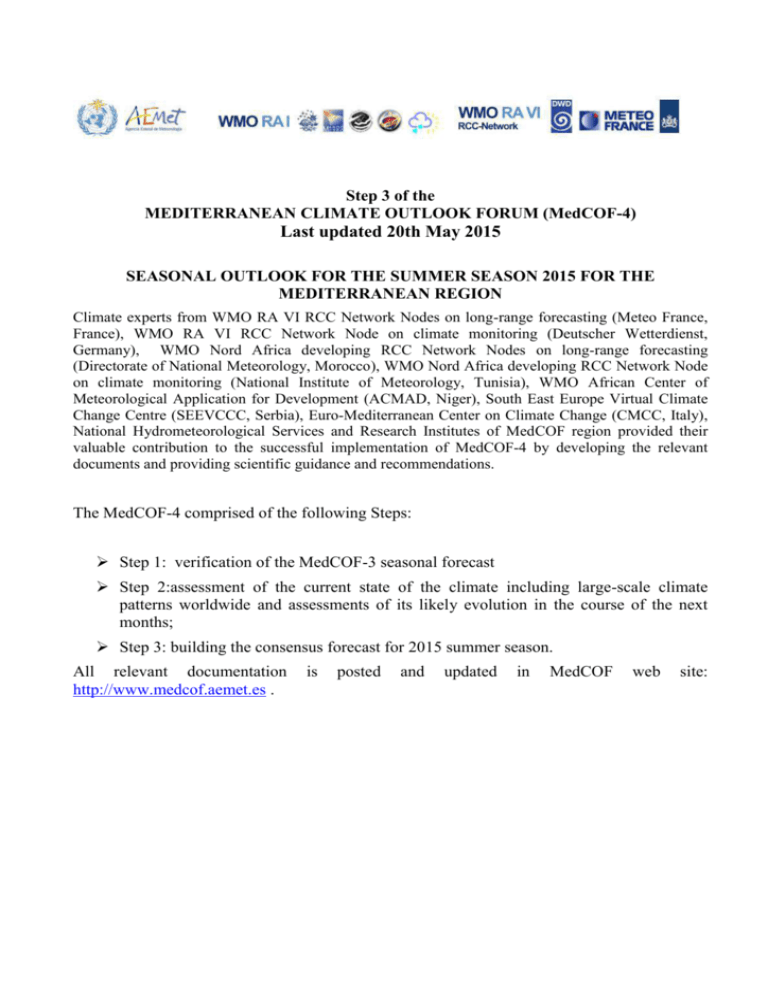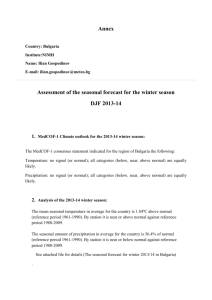Microsoft Word - May-Climate-outlook-for-SEE-region-JJA-Serbia
advertisement

Step 3 of the MEDITERRANEAN CLIMATE OUTLOOK FORUM (MedCOF-4) Last updated 20th May 2015 SEASONAL OUTLOOK FOR THE SUMMER SEASON 2015 FOR THE MEDITERRANEAN REGION Climate experts from WMO RA VI RCC Network Nodes on long-range forecasting (Meteo France, France), WMO RA VI RCC Network Node on climate monitoring (Deutscher Wetterdienst, Germany), WMO Nord Africa developing RCC Network Nodes on long-range forecasting (Directorate of National Meteorology, Morocco), WMO Nord Africa developing RCC Network Node on climate monitoring (National Institute of Meteorology, Tunisia), WMO African Center of Meteorological Application for Development (ACMAD, Niger), South East Europe Virtual Climate Change Centre (SEEVCCC, Serbia), Euro-Mediterranean Center on Climate Change (CMCC, Italy), National Hydrometeorological Services and Research Institutes of MedCOF region provided their valuable contribution to the successful implementation of MedCOF-4 by developing the relevant documents and providing scientific guidance and recommendations. The MedCOF-4 comprised of the following Steps: Step 1: verification of the MedCOF-3 seasonal forecast Step 2:assessment of the current state of the climate including large-scale climate patterns worldwide and assessments of its likely evolution in the course of the next months; Step 3: building the consensus forecast for 2015 summer season. All relevant documentation http://www.medcof.aemet.es . is posted and updated in MedCOF web site: MedCOF- 4 CLIMATE OUTLOOK FOR THE 2015 SUMMER SEASON This prediction is based on output from dynamical models, statistical models and known teleconnections of large-scale climate features. The monthly mean value in the Niño 3.4 box in April is around +0.8°C. Based on the available models, probability of El Niño conditions for JJA –including persistence or increase for the following months- is very high. Very good consistency of SST anomaly patterns for JJA among MF, ECMWF and NCEP, except in the equatorial Atlantic. In Northern Atlantic Ocean, a kind of dipole pattern is visible with a cold anomaly from Labrador to the British Isles and a warm anomaly in the Southwestern tropics (extending along the US coast). For the Mediterranean Sea most models show SST positive anomaly. The lack of consistency of the equatorial Atlantic among different models and the relative weakness of large scale drivers -as e.g. the absence of any sign of tropical influence manifested as teleconnexion patterns- over the Mediterranean region suggest that predictability for the whole season is low at present. The maps show the probabilistic consensus forecast for tercile categories of anomalies for seasonal mean temperature and precipitation, relative to the period 1981-2010. Figure 1. Graphical presentation of the 2015 summer temperature outlook Despite the low predictability diagnosed previously, most models show a gradient N-S or NW-SE for temperature anomaly over the Mediterranean region. There is a preference for the upper tercile over most of the region being this preference more marked over the South-eastern part of the domain (region 3). Figure 2. Graphical presentation of the 2015 summer precipitation outlook Precipitation in the whole MedCOF domain shows no clear scenario. The main signal refers to a slightly enhanced probability of “above normal” precipitations, possibly linked to the SST forecast over the basin, which could lead to higher risk of active convection. Unfortunately, the absence of consensus concerning the general circulation is reducing the confidence we could have in this signal. Note that it is necessary to express seasonal forecasts in terms of probability due to inherent uncertainty. Any further advice on the forecast signals, smaller scales, shorter-range updates and warnings will be available throughout the winter from the National Meteorological Services, along with details on the methodology and skill of long-range predictions. * The graphical representation of climate outlook in this statement is only for guidance purposes, and does not imply any opinion whatsoever concerning the legal status of any country, territory, city or area or of its authorities, or concerning the delimitation of its frontiers or boundaries.











